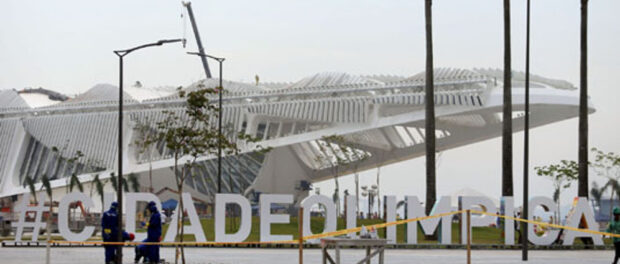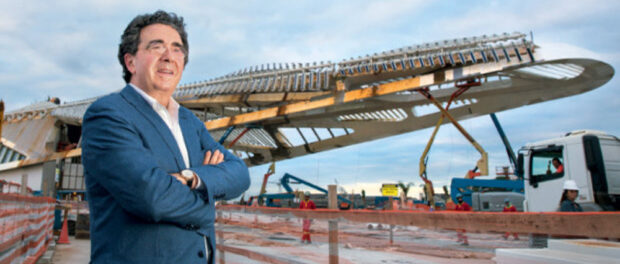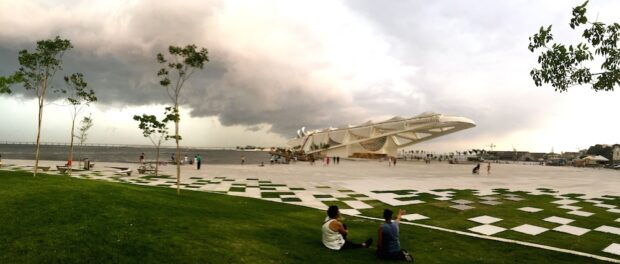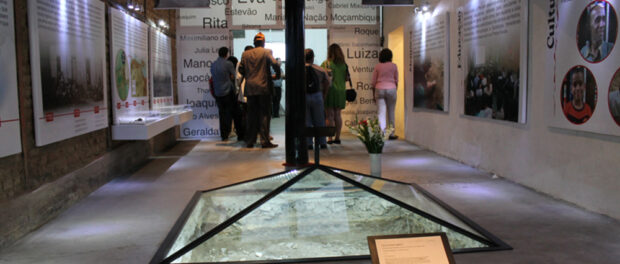
The Museum of Tomorrow, one of the most ambitious works of the Porto Maravilha Port revitalization program, is due to open its doors this Saturday, December 19. Occupying the pier that enters the Guanabara Bay in Rio’s Port Region, the museum is notable for both its spectacular appearance and for the controversies and criticisms the project has triggered during the four years of its building process, a period during which Rio’s policymakers have been criticized for actively attempting to trample over the city’s past.
After the Guggenheim attempt, the Calatrava trap
The prioritization of transforming the Port Region into a tourist attraction comes at the forefront of a wider criticism of the city model being implemented during Mayor Eduardo Paes’ mandate which focuses on mega-events and speculative development of the South, West and central zones of the city.
The urban transformations realized by Paes are reminiscent of projects realized or attempted by his predecessor and party colleague, Cesar Maia, who also sought to revitalize Barra da Tijuca in the West Zone and the downtown Port Region through the construction of expensive and supposedly emblematic cultural buildings. Maia’s failed attempts include the City of Music (now called the City of Arts), a giant white, underused building designed by French architect Christian Portzamparc and costing R$515 million in Barra da Tijuca and the project to build a branch of the Guggenheim Museum in Rio, exactly where the Museum of Tomorrow is located. Maia promoted the project as the catalyst for the revitalization of the long-abandoned Port Region.
At the time, in the early 2000s, a resistance movement led by city councilman Mario del Rei, with the support and activism of local residents and other members of civil society, insisted on the absurdity of the Guggenheim project. The project was suspended after a judicial process against Mayor Maia’s attempt was initiated. Local residents claimed there were other, more urgent priorities in the Port Region such as the building of a school and the improvement of public services.
Unlike the Guggenheim Rio project, the Museum of Tomorrow construction has gone ahead. Along with the Rio Museum of Art, huge sculpture-signs celebrating Rio as the “Olympic City” and the works for a light rail transport system, the Museum of Tomorrow is a cornerstone of a spectacular assemblage in the renovated Praça Mauá, encapsulating the ideal of a city-model finally put into practice by Paes under the Porto Maravilha, or Marvelous Port, project.

One of the key differences between the Museum of Tomorrow and Guggenheim projects is the participation of the Roberto Marinho Foundation, an organization set up by the owners of Brazil’s biggest media group Globo to support cultural projects. The Globo media network very much supported the Guggenheim project, despite the widespread criticism and resistance. With the Museum of Tomorrow, the Roberto Marinho Foundation is the primary builder of the museum in the public-private partnership that has made the project possible. In 2011, the Foundation received R$24 million from the State Environmental Conservation Fund for the construction of the Museum of Tomorrow in a transfer that was subsequently investigated by the Public Ministry. It is important to note that Globo confessed to supporting Brazil’s brutal military regime between 1964 and 1985, thus we shouldn’t exactly be expecting it to champion a Museum of Memory.
The museum’s building costs are a major source of public criticism, as is often the case with the works of Santiago Calatrava. The Spanish architect is known for doubling or tripling the budget after projects have been approved. In the case of the Museum of Tomorrow, budgetary readjustments saw an increase from R$70 million in the original project to a final cost of R$213 million. Calatrava’s buildings often impose high maintenance costs, mainly due to problems with the construction materials and the design of the structures, resulting in further public expenditure.

A museum for tomorrow but what of the past?
The Porto Maravilha revitalization project is underway in an area historically known as Pequena África (Little Africa). As the largest slave port in world history, Rio’s Port Region was the point of arrival for two million enslaved Africans. Professor of Anthropology at the Federal Fluminense University (UFF) and member of the Black Movement, Rolf Malungo de Souza emphasizes the importance of black heritage to understand the cultural-historical configuration, not only of the Port Region, but of the city of Rio and Brazil as a whole. He argues that the black population of Little Africa suffered the first form of spatial segregation in the city of Rio and were protagonists in the revolts against the imperial and military absolutist powers.
The New Blacks Institute and Cemetery (IPN by Portuguese acronym) is one of the few institutions devoted to preserving African memory in the Port Region. The IPN was founded in 1998 after Merced and Petrunio Guimarães found the remains of a mass slave grave in the foundations of their home. Following archaeological research, it was discovered the site was a cemetery for thousands of Africans who had died upon arrival or prior to sale. The Institute received some official recognition in 2009 and strategic attention and symbolic funding from the Urban Development Company of Rio de Janeiro’s Port Region (CDURP), however it operates on basic resources and relies on the volunteer work of professors, archaeologists, researchers and curators.
Merced Guimarães, founder and director of IPN, views the Museum of Tomorrow as a positive asset for the region, but is critical of the way the City is managing the area’s archaeological heritage: “I’m not going to say that I agree with the way the archaeological preservation is being carried out. But they’re inventing new concepts of museums, and it is important to have a museum like that in our region.”
Rolf Malungo de Souza, however, is more critical of the Museum of Tomorrow’s futurist content and form, and shares concern over the preservation of black heritage in the context of revitalization. He says: “The City only wants to preserve the festive part of black heritage.” He argues that the emphasis of the City’s African Heritage Circuit is samba, capoeira and carnival–cultural assets that are easily commodified to be sold as part of the Port-as-tourist-attraction, different from the Black Movement-informed African Heritage Circuit currently being promoted by Rio’s World Heritage Institute, or the UNESCO bid for world heritage status put forth by local institutions including IPN reflecting the region’s important history.
Given Rio’s urban segregation, Malungo de Souza argues, almost all of the city’s cultural institutions and attractions are located in the South and Central zones. Much more cultural investment, he says, should be made in the underserved West and North Zones. But, he concludes, the museum that would most adequately honor and represent the Port Region of Rio, one of the most significant sites in Afro-Brazilian history, is a Museum of the African Diaspora.

